An Approximation to the Environmental Impact of Economic Growth Using the Material Flow Analysis: Differences between Production and Consumption Methods, Applied to China, United Kingdom and USA (1990–2017)
Abstract
1. Introduction
2. Materials and Methods
2.1. Material Flow Analysis
- Physical Trade Balance (PTB): it is the difference between material imports and exports [18,19,23,34,42,43]. It is constructed inversely to the monetary trade balance because physical flows move in the opposite direction to monetary flows, so its interpretation is also inverse to the usual one [23,42,44].
2.2. Data
3. Results and Discussion
3.1. Production Method
3.2. Dematerialisation or Relocation?
3.3. Consumption Method
4. Conclusions
4.1. Policy Implications
- In China, the production method makes it possible to check the environmental impact occurring within its borders, which is high. However, it implies taking full responsibility for it, when part of it corresponds to the production of goods that are consumed in other countries, something that should be considered when setting environmental impact reduction targets. Considering the particularities of each country, this can be extended to other economies where the export sector is predominant, especially where processed manufactures are exported;
- The United Kingdom is one of the countries that has most reduced its environmental impact over the last decades, as measured by the production method. However, a significant part of this improvement is due to the shifting of the environmental burden to other countries through offshoring. This can be verified through the consumption method, which assigns United Kingdom a considerably higher environmental impact. It is important that this is considered when setting environmental targets, to match the true capacity of each country. The United Kingdom’s situation is generalisable to many small and medium-sized Western economies with a highly developed service sector, such as much of the European Union;
- Some characteristics of the USA, such as its large size or the high prevalence of road transport, lead to a very high environmental impact per capita, even through the production method. Like the United Kingdom, the USA depends on production in other countries, to which it transfers part of its environmental burden. However, the large size of the USA means that the burden it shifts is much greater, and environmental impact reduction strategies must be adopted to avoid such burden shifts. The characteristics of the USA make it so easy to generalise its results to other countries, but, in general terms, the implications are common to most countries with high external physical dependence.
4.2. Limitations and Future Research Ampliations
Author Contributions
Funding
Institutional Review Board Statement
Informed Consent Statement
Data Availability Statement
Conflicts of Interest
Appendix A
| Country | GDP (USD 2010) | DE (Tonnes) | MF (Tonnes) | DMC (Tonnes) | RTB (Tonnes) | PTB (Tonnes) | MF-DMC |
|---|---|---|---|---|---|---|---|
| Luxembourg | 107,638.21 | 12.39 | 104.83 | 28.15 | 92.44 | 15.76 | 76.68 |
| Norway | 90,029.36 | 54.98 | 37.56 | 21.15 | −17.41 | −33.83 | 16.41 |
| Switzerland | 76,553.28 | 9.77 | 31.67 | 13.52 | 21.90 | 3.57 | 18.15 |
| Qatar | 67,443.05 | 109.15 | 14.82 | 55.23 | −94.33 | −55.03 | −40.42 |
| Ireland | 65,432.73 | 9.75 | 21.15 | 13.94 | 11.40 | 4.19 | 7.21 |
| Denmark | 60,402.13 | 14.79 | 24.34 | 16.65 | 9.54 | 1.86 | 7.68 |
| Sweden | 56,339.99 | 20.94 | 31.78 | 17.03 | 10.84 | −3.91 | 14.75 |
| Australia | 55,079.89 | 90.63 | 42.49 | 38.38 | −48.15 | −52.41 | 4.10 |
| Singapore | 54,009.74 | 5.80 | 73.28 | 33.37 | 67.48 | 27.55 | 39.91 |
| United States of America | 52,168.13 | 20.72 | 32.29 | 21.14 | 11.57 | 0.42 | 11.14 |
| Netherlands | 51,871.58 | 8.45 | 26.75 | 14.30 | 18.30 | 5.85 | 12.45 |
| Canada | 50,262.03 | 37.00 | 34.89 | 29.02 | −2.11 | −7.98 | 5.86 |
| Austria | 47,789.39 | 13.21 | 32.39 | 15.76 | 19.18 | 2.55 | 16.63 |
| Iceland | 47,533.70 | 9.94 | 34.08 | 15.20 | 24.15 | 5.03 | 18.89 |
| Japan | 47,102.58 | 4.33 | 25.02 | 9.38 | 20.70 | 5.05 | 15.64 |
| Finland | 45,647.67 | 25.88 | 35.24 | 24.61 | 9.36 | −1.27 | 10.63 |
| Belgium | 45,507.23 | 9.71 | 23.41 | 15.88 | 13.70 | 6.18 | 7.52 |
| Germany | 45,208.06 | 11.90 | 22.59 | 15.02 | 10.69 | 3.11 | 7.57 |
| United Kingdom | 42,017.14 | 6.65 | 22.71 | 8.50 | 16.07 | 1.85 | 14.22 |
| France | 41,793.54 | 9.94 | 21.19 | 11.83 | 11.24 | 1.88 | 9.36 |
| United Arab Emirates | 40,247.75 | 37.92 | 48.09 | 20.71 | 10.16 | −17.22 | 27.38 |
| New Zealand | 36,683.09 | 23.52 | 24.55 | 24.86 | 1.03 | 1.34 | −0.31 |
| Kuwait | 35,969.35 | 55.97 | 47.06 | 29.82 | −8.91 | −26.15 | 17.24 |
| Italy | 33,961.44 | 8.32 | 20.87 | 10.90 | 12.55 | 2.58 | 9.97 |
| Israel | 33,071.41 | 9.53 | 23.83 | 13.30 | 14.30 | 3.76 | 10.54 |
| Brunei Darussalam | 32,873.47 | 45.32 | 19.55 | 23.33 | −25.78 | −21.99 | −3.79 |
| Spain | 30,549.79 | 10.00 | 23.34 | 12.00 | 13.34 | 2.00 | 11.34 |
| Cyprus | 27,897.96 | 22.66 | 34.74 | 24.43 | 12.08 | 1.76 | 10.32 |
| Bahamas | 27,583.41 | 7.99 | 20.89 | 3.25 | 12.90 | −8.43 | 17.65 |
| Malta | 26,426.68 | 9.24 | 26.71 | 16.26 | 17.47 | 7.02 | 10.45 |
| South Korea | 26,063.71 | 7.97 | 27.50 | 15.90 | 19.53 | 7.93 | 11.60 |
| Slovenia | 23,826.13 | 11.16 | 23.24 | 13.77 | 12.08 | 2.61 | 9.47 |
| Greece | 22,615.39 | 10.48 | 26.18 | 11.62 | 15.69 | 1.14 | 14.55 |
| Bahrain | 22,353.36 | 26.97 | 14.68 | 28.82 | −12.29 | 1.85 | −14.15 |
| Portugal | 22,018.01 | 9.66 | 18.42 | 11.09 | 8.76 | 1.43 | 7.33 |
| Czech Republic | 21,560.83 | 15.51 | 22.53 | 17.12 | 7.02 | 1.60 | 5.41 |
| Saudi Arabia | 21,399.11 | 34.86 | 12.31 | 24.08 | −22.54 | −10.78 | −11.77 |
| Slovakia | 18,898.18 | 8.95 | 34.41 | 10.91 | 25.46 | 1.96 | 23.50 |
| Estonia | 17,633.59 | 32.44 | 27.99 | 32.98 | −4.45 | 0.53 | −4.99 |
| Trinidad and Tobago | 16,840.12 | 30.22 | 5.37 | 18.92 | −24.85 | −14.07 | −13.55 |
| Oman | 16,658.09 | 38.48 | 10.17 | 29.57 | −28.31 | −8.91 | −19.40 |
| Barbados | 15,836.38 | 2.61 | 11.10 | 2.76 | 8.48 | 0.14 | 8.33 |
| Lithuania | 15,398.86 | 12.75 | 34.87 | 14.80 | 22.11 | 2.05 | 20.06 |
| Hungary | 14,850.43 | 12.73 | 14.34 | 16.92 | 1.61 | 4.20 | −2.58 |
| Chile | 14,722.37 | 41.68 | 17.07 | 40.93 | −24.61 | −0.76 | −23.86 |
| Poland | 14,610.88 | 16.64 | 23.24 | 17.68 | 6.60 | 1.04 | 5.56 |
| Latvia | 14,414.25 | 16.01 | 21.70 | 16.00 | 5.69 | −0.01 | 5.69 |
| Croatia | 14,111.25 | 9.24 | 15.30 | 9.79 | 6.06 | 0.56 | 5.50 |
| Uruguay | 13,938.79 | 37.46 | 35.78 | 35.83 | −1.68 | −1.63 | −0.04 |
| Turkey | 13,923.68 | 16.25 | 15.60 | 17.77 | −0.65 | 1.52 | −2.17 |
| Antigua and Barbuda | 13,328.15 | 2.44 | 13.63 | 3.28 | 11.19 | 0.84 | 10.35 |
| Seychelles | 13,187.61 | 2.15 | 21.14 | 2.46 | 19.00 | 0.31 | 18.68 |
| Brazil | 11,431.15 | 18.67 | 16.43 | 16.45 | −2.24 | −2.25 | −0.02 |
| Russian Federation | 11,355.24 | 21.04 | 9.54 | 16.36 | −11.50 | −4.68 | −6.82 |
| Malaysia | 10,912.15 | 18.83 | 23.83 | 18.86 | 5.01 | 0.01 | 4.97 |
| Panama | 10,765.91 | 5.14 | 7.93 | 7.47 | 2.79 | 2.33 | 0.46 |
| Kazakhstan | 10,617.47 | 35.70 | 17.78 | 28.21 | −17.91 | −7.59 | −10.43 |
| Argentina | 10,568.16 | 16.85 | 14.29 | 15.71 | −2.56 | −1.14 | −1.42 |
| Mexico | 10,042.14 | 9.79 | 9.62 | 9.74 | −0.17 | −0.04 | −0.13 |
| Romania | 9660.43 | 11.60 | 16.41 | 11.47 | 4.80 | −0.14 | 4.94 |
| Gabon | 9521.29 | 12.77 | 5.07 | 6.77 | −7.70 | −6.00 | −1.70 |
| Mauritius | 9476.67 | 9.25 | 20.13 | 11.65 | 10.88 | 2.40 | 8.48 |
| Costa Rica | 9219.39 | 8.32 | 8.08 | 8.48 | −0.24 | 0.16 | −0.40 |
| Suriname | 8464.76 | 13.85 | 14.37 | 13.81 | 0.52 | −0.04 | 0.56 |
| Bulgaria | 7663.72 | 18.84 | 12.11 | 18.70 | −6.73 | −0.14 | −6.59 |
| Botswana | 7613.70 | 28.25 | 33.59 | 29.11 | 5.33 | 0.86 | 4.48 |
| Colombia | 7580.28 | 8.77 | 10.36 | 6.67 | 1.59 | −2.10 | 3.69 |
| South Africa | 7556.79 | 14.28 | 8.64 | 11.69 | −5.64 | −2.59 | −3.05 |
| Maldives | 7501.55 | 4.20 | 16.39 | 7.49 | 12.19 | 3.28 | 8.90 |
| Montenegro | 7286.46 | 11.18 | 24.92 | 12.78 | 13.73 | 1.59 | 12.14 |
| Turkmenistan | 6693.93 | 24.08 | 21.42 | 16.64 | −2.66 | −7.44 | 4.78 |
| Dominican Republic | 6661.87 | 5.21 | 6.55 | 5.77 | 1.33 | 0.56 | 0.77 |
| Cuba | 6522.74 | 7.36 | 8.09 | 8.16 | 0.72 | 0.80 | −0.07 |
| China | 6500.42 | 22.42 | 19.94 | 23.65 | −2.47 | 1.23 | −3.70 |
| Lebanon | 6487.90 | 7.57 | 15.35 | 10.05 | 7.78 | 2.48 | 5.30 |
| Belarus | 6384.82 | 16.13 | 0.40 | 16.60 | −15.73 | 0.47 | −16.19 |
| Namibia | 6274.75 | 10.85 | 8.16 | 11.02 | −2.69 | 0.17 | −2.86 |
| Serbia | 6157.25 | 14.03 | 19.72 | 14.27 | 5.69 | 0.23 | 5.46 |
| Peru | 6114.23 | 15.55 | 9.38 | 15.14 | −6.17 | −0.44 | −5.76 |
| Iran | 6070.19 | 15.34 | 13.83 | 14.44 | −1.51 | −0.91 | −0.61 |
| Azerbaijan | 6063.72 | 12.53 | 5.85 | 8.42 | −6.68 | −4.10 | −2.58 |
| Libya | 5899.90 | 11.40 | 3.80 | 10.81 | −7.60 | −0.59 | −7.01 |
| Thailand | 5741.35 | 11.78 | 14.43 | 12.30 | 2.64 | 0.52 | 2.12 |
| Bosnia and Herzegovina | 5352.72 | 11.36 | 8.79 | 11.94 | −2.57 | 0.59 | −3.15 |
| Ecuador | 5330.54 | 10.14 | 10.70 | 9.09 | 0.56 | −1.05 | 1.61 |
| Iraq | 5295.99 | 9.09 | 2.75 | 6.25 | −6.34 | −2.84 | −3.50 |
| Guyana | 5257.46 | 25.25 | 116.73 | 24.74 | 91.49 | −0.51 | 92.00 |
| Macedonia | 5105.40 | 12.50 | 13.28 | 13.94 | 0.77 | 1.44 | −0.66 |
| Paraguay | 4944.19 | 13.36 | 14.64 | 12.15 | 1.28 | −1.22 | 2.49 |
| Algeria | 4775.87 | 9.91 | 3.04 | 8.72 | −6.87 | −1.19 | −5.68 |
| Jamaica | 4722.05 | 8.26 | 8.26 | 7.13 | 0.00 | −1.14 | 1.14 |
| Albania | 4524.37 | 9.41 | 10.86 | 9.70 | 1.45 | 0.22 | 1.16 |
| Fiji Islands | 4352.47 | 6.28 | 7.21 | 6.86 | 0.93 | 0.58 | 0.35 |
| Tunisia | 4308.42 | 8.52 | 6.21 | 9.20 | −2.31 | 0.68 | −2.99 |
| Belize | 4300.56 | 12.03 | 7.95 | 11.98 | −4.09 | −0.05 | −4.03 |
| Georgia | 4185.81 | 4.86 | 8.47 | 6.25 | 3.61 | 1.39 | 2.22 |
| Armenia | 3923.72 | 9.09 | 7.37 | 9.99 | −1.72 | 0.90 | −2.62 |
| Mongolia | 3895.41 | 40.19 | 13.29 | 33.49 | −26.90 | −6.70 | −20.21 |
| Indonesia | 3824.27 | 8.61 | 6.02 | 7.19 | −2.59 | −1.42 | −1.17 |
| Angola | 3748.32 | 8.52 | 3.75 | 5.42 | −4.77 | −3.11 | −1.67 |
| Sri Lanka | 3647.39 | 4.42 | 3.93 | 5.36 | −0.49 | 0.94 | −1.43 |
| Samoa | 3558.12 | 4.68 | 7.61 | 5.13 | 2.93 | 0.45 | 2.48 |
| Cape Verde | 3414.56 | 5.84 | 8.50 | 6.74 | 2.67 | 0.91 | 1.76 |
| Jordan | 3350.39 | 8.59 | 8.18 | 9.52 | −0.40 | 0.93 | −1.34 |
| El Salvador | 3314.70 | 4.81 | 6.31 | 5.43 | 1.50 | 0.61 | 0.88 |
| Morocco | 3222.05 | 7.04 | 3.83 | 7.66 | −3.21 | 0.62 | −3.84 |
| Guatemala | 3210.87 | 6.42 | 3.82 | 6.54 | −2.60 | 0.11 | −2.72 |
| Rep Congo | 3097.28 | 6.10 | 2.39 | 3.81 | −3.71 | −2.29 | −1.42 |
| Moldova | 2953.72 | 7.61 | 3.54 | 8.26 | −4.07 | 0.65 | −4.72 |
| Ukraine | 2828.89 | 13.97 | 11.35 | 11.80 | −2.62 | −2.16 | −0.46 |
| Vanuatu | 2781.79 | 6.01 | 7.47 | 6.04 | 1.46 | 0.03 | 1.43 |
| Bhutan | 2780.82 | 12.86 | 10.22 | 10.25 | −2.64 | −2.63 | −0.03 |
| Philippines | 2735.19 | 4.14 | 4.37 | 3.97 | 0.23 | −0.19 | 0.39 |
| Egypt | 2704.92 | 7.03 | 4.88 | 7.61 | −2.15 | 0.58 | −2.72 |
| Nigeria | 2549.72 | 4.06 | 2.73 | 3.49 | −1.34 | −0.57 | −0.76 |
| Bolivia | 2361.06 | 13.94 | 5.39 | 12.56 | −8.55 | −1.38 | −7.17 |
| Papua New Guinea | 2336.81 | 9.54 | 2.73 | 10.95 | −6.81 | 1.41 | −8.22 |
| Uzbekistan | 2138.57 | 9.51 | 6.14 | 9.28 | −3.37 | −0.23 | −3.14 |
| Honduras | 2067.29 | 5.56 | 4.37 | 5.69 | −1.19 | 0.05 | −1.32 |
| Nicaragua | 1836.01 | 6.13 | 4.20 | 6.47 | −1.93 | 0.34 | −2.27 |
| Sudan | 1825.72 | 4.45 | 4.36 | 4.63 | −0.09 | 0.19 | −0.27 |
| India | 1751.66 | 5.05 | 4.45 | 5.34 | −0.59 | 0.29 | −0.88 |
| Mauritania | 1732.59 | 10.06 | 2.59 | 7.52 | −7.47 | −2.54 | −4.93 |
| Vietnam | 1667.17 | 13.52 | 11.79 | 13.59 | −1.73 | 0.08 | −1.80 |
| Zambia | 1641.01 | 8.04 | 3.39 | 8.07 | −4.65 | 0.03 | −4.68 |
| Ghana | 1625.91 | 6.58 | 3.56 | 6.84 | −3.02 | 0.26 | −3.28 |
| Laos | 1538.85 | 10.76 | 6.60 | 10.61 | −4.16 | −0.16 | −4.00 |
| Cote d’Ivoire | 1463.71 | 2.94 | 0.98 | 3.08 | −1.96 | 0.14 | −2.09 |
| Cameroon | 1441.78 | 3.93 | 1.87 | 4.03 | −2.05 | 0.11 | −2.16 |
| Senegal | 1384.52 | 3.04 | 2.42 | 3.21 | −0.62 | 0.17 | −0.79 |
| Lesotho | 1363.93 | 11.61 | 11.48 | 11.82 | −0.14 | 0.21 | −0.34 |
| Myanmar | 1335.20 | 3.43 | 1.35 | 3.30 | −2.08 | −0.13 | −1.95 |
| Haiti | 1260.60 | 1.39 | 1.34 | 1.59 | −0.05 | 0.20 | −0.25 |
| Zimbabwe | 1234.10 | 3.47 | 3.42 | 3.59 | −0.05 | 0.12 | −0.17 |
| Sao Tome and Principe | 1232.17 | 3.01 | 6.04 | 3.37 | 3.03 | 0.35 | 2.67 |
| Benin | 1129.00 | 4.62 | 4.28 | 5.01 | −0.34 | 0.38 | −0.73 |
| Kenya | 1093.13 | 3.05 | 3.07 | 3.28 | 0.02 | 0.22 | −0.20 |
| Pakistan | 1081.29 | 4.19 | 3.16 | 4.43 | −1.03 | 0.24 | −1.27 |
| Cambodia | 1024.62 | 4.33 | 3.38 | 4.88 | −0.95 | 0.55 | −1.50 |
| Kyrgyzstan | 1021.16 | 7.33 | 8.52 | 8.20 | 1.19 | 0.88 | 0.31 |
| Bangladesh | 1002.39 | 2.35 | 2.28 | 2.58 | −0.06 | 0.23 | −0.29 |
| Chad | 956.66 | 2.57 | 1.59 | 2.59 | −0.98 | 0.02 | −1.00 |
| Tajikistan | 936.00 | 3.04 | 3.55 | 3.37 | 0.52 | 0.34 | 0.18 |
| Uganda | 903.85 | 2.98 | 2.63 | 3.03 | −0.35 | 0.05 | −0.40 |
| Tanzania | 872.00 | 3.22 | 1.44 | 3.35 | −1.78 | 0.13 | −1.91 |
| Yemen | 785.34 | 1.92 | 1.09 | 2.23 | −0.83 | 0.31 | −1.14 |
| Rwanda | 764.62 | 2.80 | 3.04 | 2.87 | 0.25 | 0.07 | 0.18 |
| Gambia | 754.99 | 2.24 | 2.29 | 2.47 | 0.05 | 0.23 | −0.18 |
| Guinea | 750.40 | 5.05 | 2.21 | 3.64 | −2.84 | −1.41 | −1.43 |
| Nepal | 732.00 | 3.55 | 2.70 | 3.79 | −0.85 | 0.25 | −1.09 |
| South Sudan | 730.93 | 1.38 | 1.26 | 0.78 | −0.12 | −0.84 | 0.48 |
| Mali | 729.63 | 5.56 | 4.55 | 5.69 | −1.01 | 0.12 | −1.13 |
| Burkina Faso | 726.71 | 4.16 | 3.82 | 4.27 | −0.33 | 0.11 | −0.44 |
| Togo | 630.94 | 4.22 | 2.57 | 4.25 | −1.64 | 0.00 | −1.68 |
| Mozambique | 580.05 | 2.49 | 1.93 | 2.41 | −0.56 | −3.96 | −0.47 |
| Afghanistan | 574.18 | 1.86 | 1.28 | 2.00 | −0.58 | 0.15 | −0.72 |
| Liberia | 571.45 | 3.22 | 1.69 | 3.29 | −1.53 | 0.07 | −1.60 |
| Niger | 520.76 | 3.43 | 3.26 | 3.49 | −0.16 | 0.06 | −0.22 |
| Malawi | 507.55 | 3.34 | 1.22 | 3.36 | −2.12 | 0.02 | −2.14 |
| Ethiopia | 482.64 | 2.94 | 0.70 | 3.02 | −2.24 | 0.08 | −2.32 |
| Madagascar | 469.94 | 2.28 | 0.83 | 2.40 | −1.46 | 0.12 | −1.58 |
| Sierra Leone | 441.14 | 6.53 | 5.93 | 6.41 | −0.59 | −0.38 | −0.47 |
| DR Congo | 411.02 | 2.30 | 2.03 | 2.33 | −0.28 | 0.03 | −0.30 |
| Central African Republic | 346.69 | 3.08 | 2.33 | 3.10 | −0.75 | 0.02 | −0.77 |
| Burundi | 228.43 | 1.62 | 1.50 | 1.66 | −0.13 | 0.04 | −0.16 |
References
- Naredo, J.M. Economía y Sostenibilidad. La Economía Ecológica En Perspectiva. POLIS Rev. Latinoam. 2001, 1, 27. [Google Scholar]
- Meadows, D.H.; Meadows, D.L.; Randers, J.; Behrens, W.W., III. The Limits to Growth. A Report for The Club of Rome’s Project on the Predicament of Mankind; Universe Books: New York, NY, USA, 1972. [Google Scholar]
- United Nations. Report of the World Commission on Environment and Development: Our Common Future; United Nations: New York, NY, USA, 1987. [Google Scholar]
- Shafik, N.; Bandyopadhyay, S. Ecomomic Growth and Enivronmental Quality, Time Series Anda Cross-Country Evidence; World Development Report; World Bank Group: Washington, DC, USA, 1992. [Google Scholar]
- Panayotou, T. Environmental Degradation at Different Stages of Economic Development. In Beyond Rio; Ahmed, I., Doeleman, J.A., Eds.; Palgrave Macmillan: London, UK, 1995; pp. 13–36. [Google Scholar]
- Castells, M. La Era de La Información; Alianza: Madriz, Nicaragua, 1997. [Google Scholar]
- Aruga, K. Investigating the Energy-Environmental Kuznets Curve Hypothesis for the Asia-Pacific Region. Sustainability 2019, 11, 2395. [Google Scholar] [CrossRef]
- Maneejuk, N.; Ratchakom, S.; Maneejuk, P.; Yamaka, W. Does the Environmental Kuznets Curve Exist? An International Study. Sustainability 2020, 12, 9117. [Google Scholar] [CrossRef]
- Scheel, C.; Aguiñaga, E.; Bello, B. Decoupling Economic Development from the Consumption of Finite Resources Using Circular Economy. A Model for Developing Countries. Sustainability 2020, 12, 1291. [Google Scholar] [CrossRef]
- Shao, Q.; Schaffartzik, A.; Mayer, A.; Krausmann, F. The High ‘Price’ of Dematerialization: A Dynamic Panel Data Analysis of Material Use and Economic Recession. J. Clean. Prod. 2017, 167, 120–132. [Google Scholar] [CrossRef]
- Bampatsou, C.; Halkos, G.; Dimou, A. Determining Economic Productivity under Environmental and Resource Pressures: An Empirical Application. J. Econ. Struct. 2017, 6, 12. [Google Scholar] [CrossRef]
- Cohen, G.; Jalles, J.T.; Loungani, P.; Marto, R. The Long-Run Decoupling of Emissions and Output: Evidence from the Largest Emitters. Energy Policy 2018, 118, 58–68. [Google Scholar] [CrossRef]
- Steinberger, J.K.; Krausmann, F.; Getzner, M.; Schandl, H.; West, J. Development and Dematerialization: An International Study. PLoS ONE 2013, 8, e70385. [Google Scholar] [CrossRef]
- Martínez-Alier, J.; Pascual, U.; Vivien, F.-D.; Zaccai, E. Sustainable De-Growth: Mapping the Context, Criticisms and Future Prospects of an Emergent Paradigm. Ecol. Econ. 2010, 69, 1741–1747. [Google Scholar] [CrossRef]
- Adriaanse, A. Resource Flows: The Material Basis of Industrial Economies; World Resources Institute: Washington, DC, USA, 1997. [Google Scholar]
- Bithas, K.; Kalimeris, P. Unmasking Decoupling: Redefining the Resource Intensity of the Economy. Sci. Total Environ. 2018, 619–620, 338–351. [Google Scholar] [CrossRef]
- Steinberger, J.K.; Krausmann, F. Material and Energy Productivity. Policy Anal. 2011, 45, 1169–1176. [Google Scholar] [CrossRef]
- Schandl, H.; Fischer-Kowalski, M.; West, J.; Giljum, S.; Dittrich, M.; Eisenmenger, N.; Geschke, A.; Lieber, M.; Wieland, H.; Schaffartzik, A.; et al. Global Material Flows and Resource Productivity: Forty Years of Evidence: Global Material Flows and Resource Productivity. J. Ind. Ecol. 2018, 22, 827–838. [Google Scholar] [CrossRef]
- Wiedmann, T.O.; Schandl, H.; Lenzen, M.; Moran, D.; Suh, S.; West, J.; Kanemoto, K. The Material Footprint of Nations. Proc. Natl. Acad. Sci. USA 2015, 112, 6271–6276. [Google Scholar] [CrossRef] [PubMed]
- Carpintero, Ó. Los costes ambientales del sector servicios y la nueva economía: Entre la desmaterialización y el efecto rebote. Econ. Ind. 2003, 352, 59–76. [Google Scholar]
- Carpintero, Ó. Pautas de consumo, desmaterialización y ‘nueva economía’: Entre la realidad y el deseo. In Necesidades, Consumo y Sostenibilidad; Colección Urbanitats; CCCB/Bakeaz: Barcelona, Spain, 2003. [Google Scholar]
- Pothen, F.; Schymura, M. Bigger Cakes with Fewer Ingredients? A Comparison of Material Use of the World Economy. Ecol. Econ. 2015, 109, 109–121. [Google Scholar] [CrossRef]
- Krausmann, F.; Schandl, H.; Eisenmenger, N.; Giljum, S.; Jackson, T. Material Flow Accounting: Measuring Global Material Use for Sustainable Development. Annu. Rev. Environ. Resour. 2017, 42, 647–675. [Google Scholar] [CrossRef]
- Arto, I.; Roca, J.; Serrano, M. Emisiones territoriales y fuga de emisiones. Análisis del caso español. Rev. Iberoam. Econ. Ecol. 2012, 18, 73–87. [Google Scholar]
- Dittrich, M.; Giljum, S.; Lutter, S.; Polzin, C. Green Economies around the World? Implications of Resource Use for Development and the Environment; Sustainable Europe Research Institute (SERI): Vienna, Austria, 2012. [Google Scholar]
- Knight, K.W.; Schor, J.B. Economic Growth and Climate Change: A Cross-National Analysis of Territorial and Consumption-Based Carbon Emissions in High-Income Countries. Sustainability 2014, 6, 3722–3731. [Google Scholar] [CrossRef]
- Eisenmenger, N.; Giljum, S.; Lutter, S.; Marques, A.; Theurl, M.; Pereira, H.; Tukker, A. Towards a Conceptual Framework for Social-Ecological Systems Integrating Biodiversity and Ecosystem Services with Resource Efficiency Indicators. Sustainability 2016, 8, 201. [Google Scholar] [CrossRef]
- Ayres, R.U.; Kneese, A.V. Production, Consumption, and Externalities. Am. Econ. Rev. 1969, 59, 282–297. [Google Scholar]
- Ayres, R.U.; Ayres, L. Accounting for Resources: Economy-Wide Applications of Mass-Balance Principles to Materials and Waste; Edward Elgar: Camberley, UK, 1998. [Google Scholar]
- Daniels, P.L.; Moore, S. Approaches for Quantifying the Metabolism of Physical Economies: Part I: Methodological Overview. J. Ind. Ecol. 2001, 5, 69–93. [Google Scholar] [CrossRef]
- Daniels, P.L. Approaches for Quantifying the Metabolism of Physical Economies: A Comparative Survey: Part II: Review of Individual Approaches. J. Ind. Ecol. 2002, 6, 65–88. [Google Scholar] [CrossRef]
- Steurer, A.; Schutz, H. Economy-Wide Material Flow Accounts and Derived Indicators: A Methodological Guide; Eurostat, Ed.; Office for Official Publications of the European Communities: Luxembourg, 2001. [Google Scholar]
- Fischer-Kowalski, M.; Krausmann, F.; Giljum, S.; Lutter, S.; Mayer, A.; Bringezu, S.; Moriguchi, Y.; Schütz, H.; Schandl, H.; Weisz, H. Methodology and Indicators of Economy-Wide Material Flow Accounting. J. Ind. Ecol. 2011, 15, 855–876. [Google Scholar] [CrossRef]
- EUROSTAT. Economy-Wide Material Flow Accounts Handbook: 2018 Edition; Publications Office of the European Union: Luxembourg, 2018. [Google Scholar]
- Fischer-Kowalski, M.; Haberl, H. Sustainable Development: Socio-economic Metabolism and Colonization of Nature. Int. Soc. Sci. J. 1998, 50, 573–587. [Google Scholar] [CrossRef]
- Ayres, R.U.; Simonis, U.E. Industrial Metabolism: Restructuring for Sustainable Development; United Nations University Press: New York, NY, USA, 1994. [Google Scholar]
- Fischer-Kowalski, M.; Weisz, H. Society as Hybrid between Material and Symbolic Realms: Toward a Theoretical Framework of Society-Nature Interaction. Adv. Hum. Ecol. 1999, 8, 215–251. [Google Scholar]
- Georgescu-Roegen, N. La Ley de Entropía y El Proceso Económico; Fundación Argentaria: Madrid, Spain, 1996. [Google Scholar]
- Piñero, P.; Bruckner, M.; Wieland, H.; Pongrácz, E.; Giljum, S. The Raw Material Basis of Global Value Chains: Allocating Environmental Responsibility Based on Value Generation. Econ. Syst. Res. 2019, 31, 206–227. [Google Scholar] [CrossRef]
- Schandl, H.; Fischer-Kowalski, M.; West, J.; Giljum, S.; Dittrich, M.; Eisenmenger, N.; Geschke, A.; Lieber, M.; Wieland, H.; Schaffartzik, A.; et al. Global Material Flows and Resource Productivity, Assessment Study for the UNEP International Resource Panel; United Nations Environment Programme: Paris, France, 2016. [Google Scholar]
- Schaffartzik, A.; Wiedenhofer, D.; Eisenmenger, N. Raw Material Equivalents: The Challenges of Accounting for Sustainability in a Globalized World. Sustainability 2015, 7, 5345–5370. [Google Scholar] [CrossRef]
- Carpintero, Ó. El Metabolismo Económico Regional Español: Glosario de Términos; FUHEM Ecosocial: Madrid, Spain, 2015. [Google Scholar]
- Anke Schaffartzik; Melanie Pichler Extractive Economies in Material and Political Terms: Broadening the Analytical Scope. Sustainability 2017, 9, 1047. [CrossRef]
- Eisenmenger, N.; Fischer-Kowalski, M.; Weisz, H. Indicators of natural resource use and consumption. In Sustainability Indicators; SCOPE: Washington, DC, USA, 2007; pp. 193–211. [Google Scholar]
- UNEP. Decoupling Natural Resource Use and Environmental Impacts from Economic Growth; UNEP: Nairobi, Kenya, 2011. [Google Scholar]
- Fischer-Kowalski, M.; Haberl, H. Social metabolism: A metric for biophysical growth and degrowth. In Handbook of Ecological Economics; Edward Elgard: Cheltenham, UK, 2015; pp. 100–138. [Google Scholar]
- Ruffing, K. Indicators to measure decoupling of environmental pressure from economic growth. In Sustainability Indicators: A Scientific Assessment; SCOPE: Washington, DC, USA, 2007; pp. 221–223. [Google Scholar]
- Giljum, S.; Hak, T.; Hinterberger, F.; Kovanda, J. Environmental Governance in the European Union: Strategies and Instruments for Absolute Decoupling. Int. J. Sustain. Dev. 2005, 8, 31. [Google Scholar] [CrossRef]
- Martínez-Alier, J. Los Conflictos Ecológico-Distributivos y Los Indicadores de Sustentabilidad. Rev. Iberoam. Econ. Ecol. 2004, 1, 21–30. [Google Scholar]
- UNEP. Assessing the Environmental Impacts of Consumption and Production. Int. J. Sustain. High. Educ. 2010, 11. [Google Scholar] [CrossRef]
- Dittrich, M.; Bringezu, S.; Schütz, H. The Physical Dimension of International Trade, Part 2: Indirect Global Resource Flows between 1962 and 2005. Ecol. Econ. 2012, 79, 32–43. [Google Scholar] [CrossRef]
- United Nations Environment Programme International Resource Panel Global Material Flows Database. Available online: https://www.resourcepanel.org/global-material-flows-database (accessed on 1 March 2021).
- Weisz, H.; Krausmann, F.; Amann, C.; Eisenmenger, N.; Erb, K.-H.; Hubacek, K.; Fischer-Kowalski, M. The Physical Economy of the European Union: Cross-Country Comparison and Determinants of Material Consumption. Ecol. Econ. 2006, 58, 676–698. [Google Scholar] [CrossRef]
- Fernández-Herrero, L.; Duro, J.A. What Causes Inequality in Material Productivity between Countries? Ecol. Econ. 2019, 162, 1–16. [Google Scholar] [CrossRef]
- Palazuelos, E.; Machín, A. Ruidos y Silencios de La Política Energética de Estados Unidos. Econ. UNAM 2008, 14, 7–36. [Google Scholar]
- Bradshaw, C.J.A.; Giam, X.; Sodhi, N.S. Evaluating the Relative Environmental Impact of Countries. PLoS ONE 2010, 5, e10440. [Google Scholar] [CrossRef]
- Palazuelos, E.; García, C. La Transición Energética en China. Rev. Econ. Mund. 2008, 20, 165–196. [Google Scholar]
- Pérez Lagüela, E. El metabolismo de la economía china. Una visión del desarrollo desde la Economía ecológica. Rev. Econ. Mund. 2017. [Google Scholar] [CrossRef]
- Levy, D. Offshoring in the New Global Political Economy. J. Manag. Stud. 2005, 685–693. [Google Scholar] [CrossRef]
- Santarcángelo, J.; Schteingart, D.; Porta, F. Cadenas Globales de Valor: Una mirada crítica a una nueva forma de pensar el desarrollo. Cuad. Econ. Crítica 2017, 4, 99–129. [Google Scholar]
- Álvarez, N.; Medialdea, B. Revista de Economía Mundial; Universidad Huelva: Huelva, Spain, 2010; pp. 165–191. [Google Scholar]
- Palomo Garrido, A. Desarrollo y consecuencias de la globalización financiera. Nómadas Rev. Crítica Cienc. Soc. Juríd. 2013, 35, 353–373. [Google Scholar] [CrossRef]
- Carpintero, Ó.; Naredo, J.M. Sobre Financiarización y Neoextractivismo. Papeles Relac. Ecosociales 2018, 143, 97–108. [Google Scholar]
- Salvador, A.I. El proceso de apertura de la economía china a la inversión extranjera. Rev. Econ. Mund. 2012, 30, 209–231. [Google Scholar]
- Salvador, A.I. El proceso de reforma económica de China y su adhesión a la OMC. Pecvnia Rev. Fac. Cienc. Económicas Empres. Univ. 2008, 7, 257–284. [Google Scholar] [CrossRef]
- Bustelo, P.; Fernández Lommen, Y. Gradualismo y factores estructurales en la reforma económica china (1978–1995). Doc. Trab. Fac. Cienc. Económicas Empres. 1996, 11, 1–28. [Google Scholar]
- Claro, S. 25 años de reformas económicas en China: 1978–2003. Cuad. Inf. Econ. 2003, 186, 74–81. [Google Scholar]
- Bustelo, P. China 2006–2010: ¿Hacia una Nueva Pauta de Desarrollo? Real Instituto Elcano de Estudios Internacionales y Estratégicos: Madrid, Spain, 2005. [Google Scholar]
- Lommen, Y.F. El futuro incierto de China. Retos del duodécimo Plan Quinquenal. Estud. Política Exter. 2011, 56, 46–54. [Google Scholar]
- Pérez, Á.P. Boletín del Instituto Español de Estudios Estratégicos; Publicaciones Defensa: Madrid, Spain, 2016; pp. 709–724. [Google Scholar]
- Bustillo, I.; Artecona, R.; Makhoul, I.; Perrotti, D. Energía y Políticas Públicas en Estados Unidos. Una Relación Virtuosa Para El Desarrollo de Fuentes No Convencionales; CEPAL: Santiago, Chile, 2015. [Google Scholar]
- Hudson, R.; Sadler, D. State Policies and the Changing Geography of the Coal Industry in the United Kingdom in the 1980s and 1990s. Trans. Inst. Br. Geogr. 1990, 15, 435–454. [Google Scholar] [CrossRef]
- Xun, S. Minerals Yearbook: The Mineral Industry of China; USGS: Washington, DC, USA, 2018.
- Bruckner, M.; Giljum, S.; Lutz, C.; Wiebe, K.S. Materials Embodied in International Trade—Global Material Extraction and Consumption between 1995 and 2005. Glob. Environ. Chang. 2012, 22, 568–576. [Google Scholar] [CrossRef]
- Piñero, P.; Pérez-Neira, D.; Infante-Amate, J.; Chas-Amil, M.L.; Doldán-García, X.R. Unequal Raw Material Exchange between and within Countries: Galicia (NW Spain) as a Core-Periphery Economy. Ecol. Econ. 2020, 172, 106621. [Google Scholar] [CrossRef]
- Muñoz, P.; Giljum, S.; Roca, J. The Raw Material Equivalents of International Trade. J. Ind. Ecol. 2009, 13, 881–897. [Google Scholar] [CrossRef]
- Chen, X.; Mao, J.; Tian, H. Analysis of China’s Iron Trade Flow: Quantity, Value and Regional Pattern. Sustainability 2020, 12, 10427. [Google Scholar] [CrossRef]
- Huang, J. The Prospects for China’s Food Security and Imports: Will China Starve the World via Imports? J. Integr. Agric. 2017, 16, 2933–2944. [Google Scholar] [CrossRef]
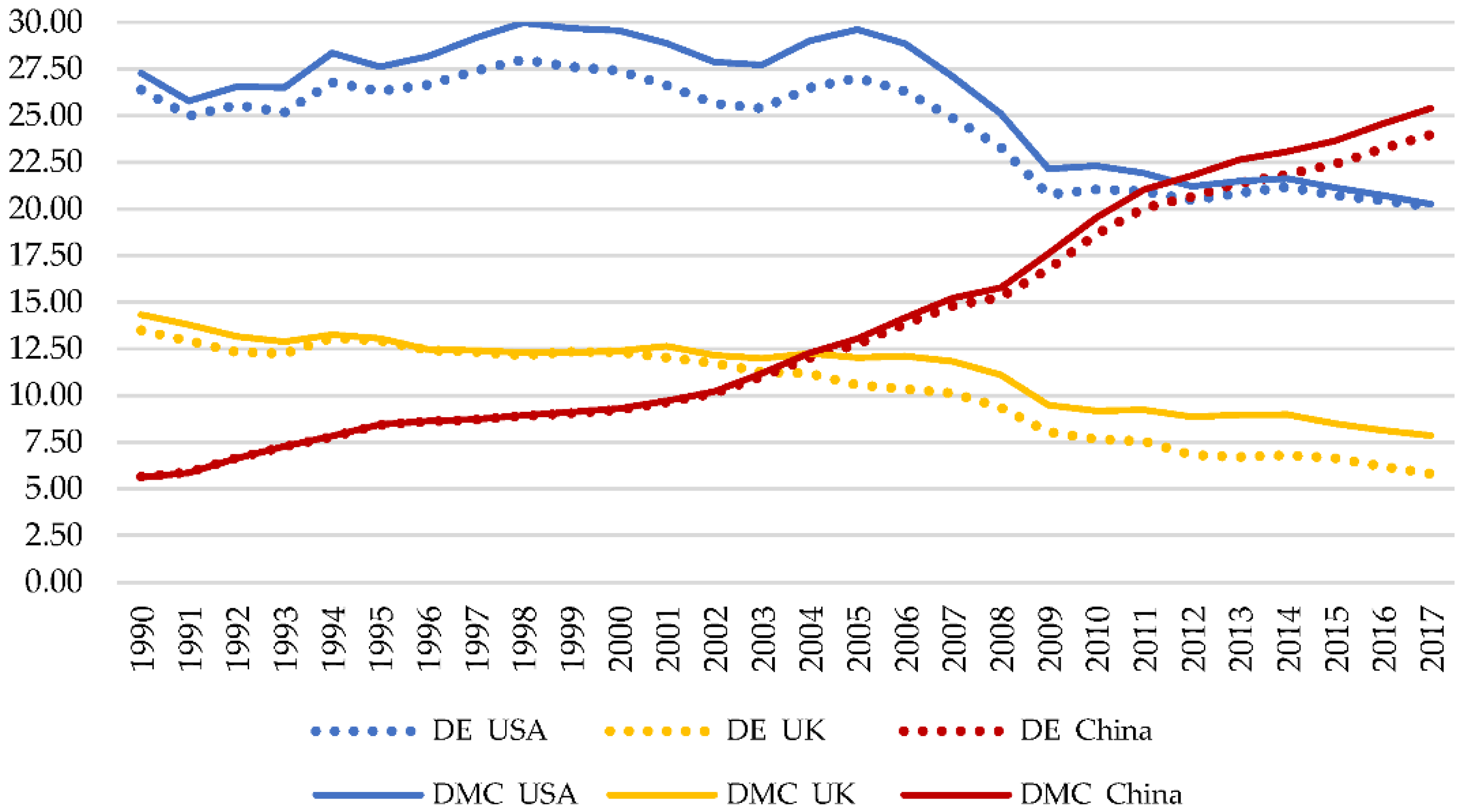
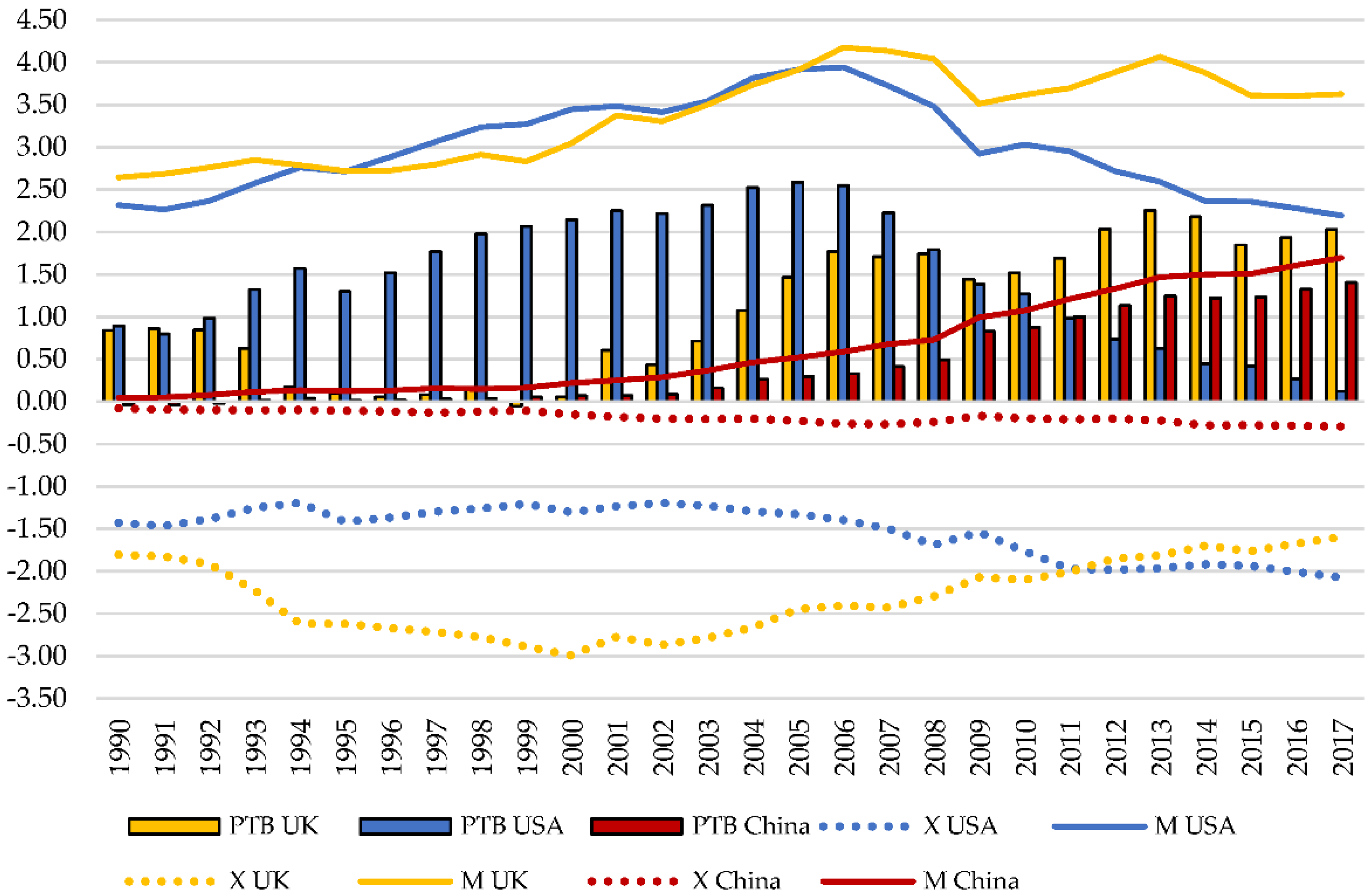
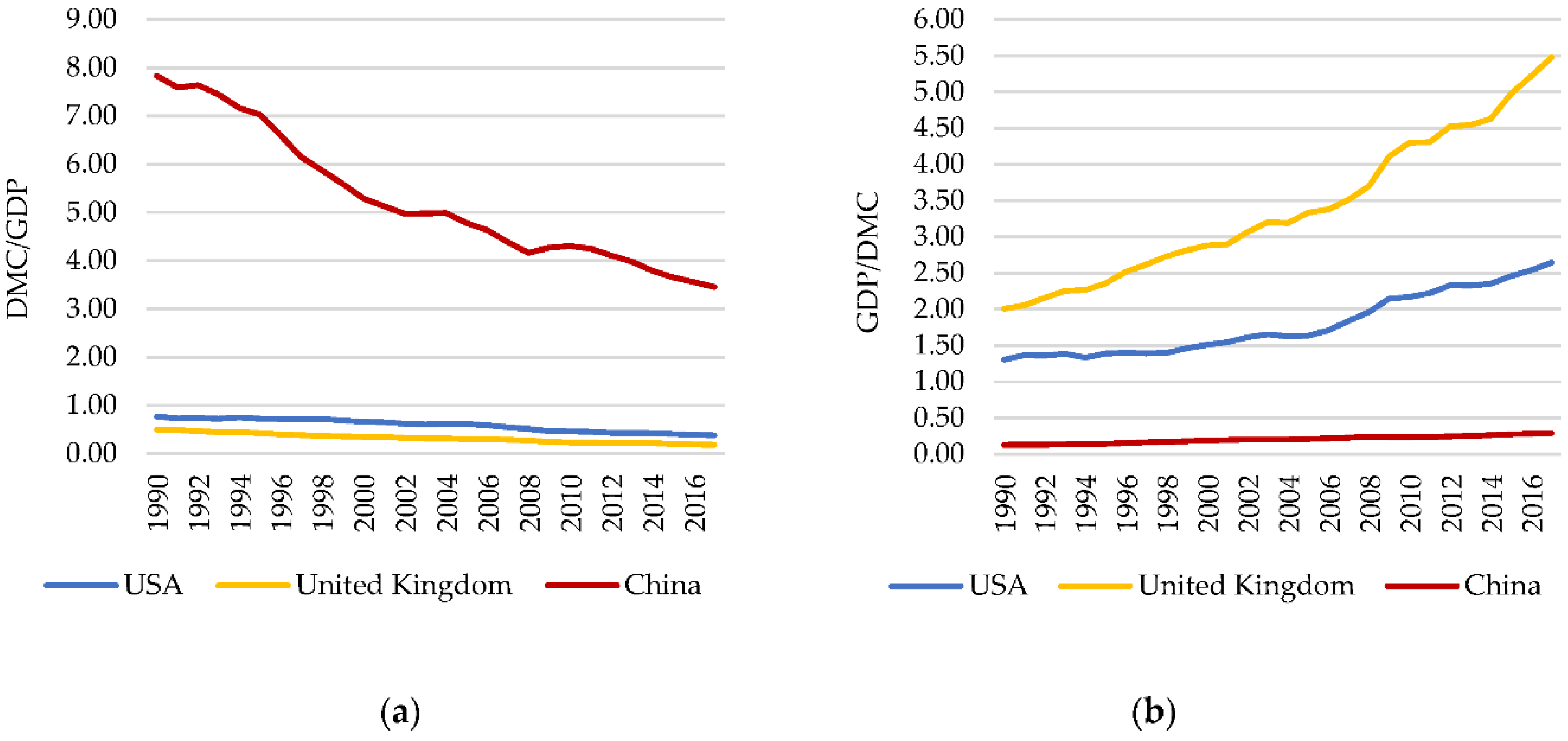
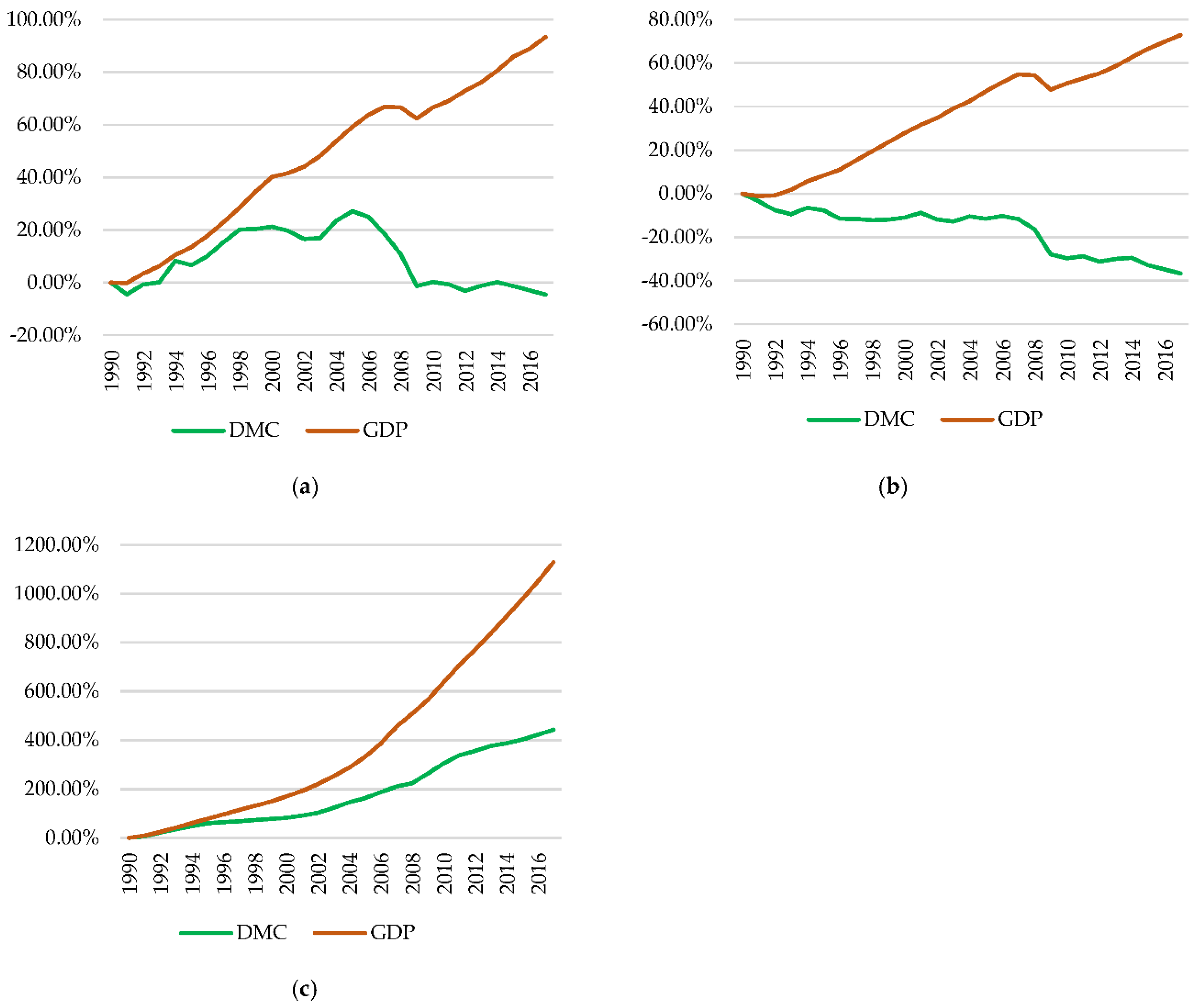

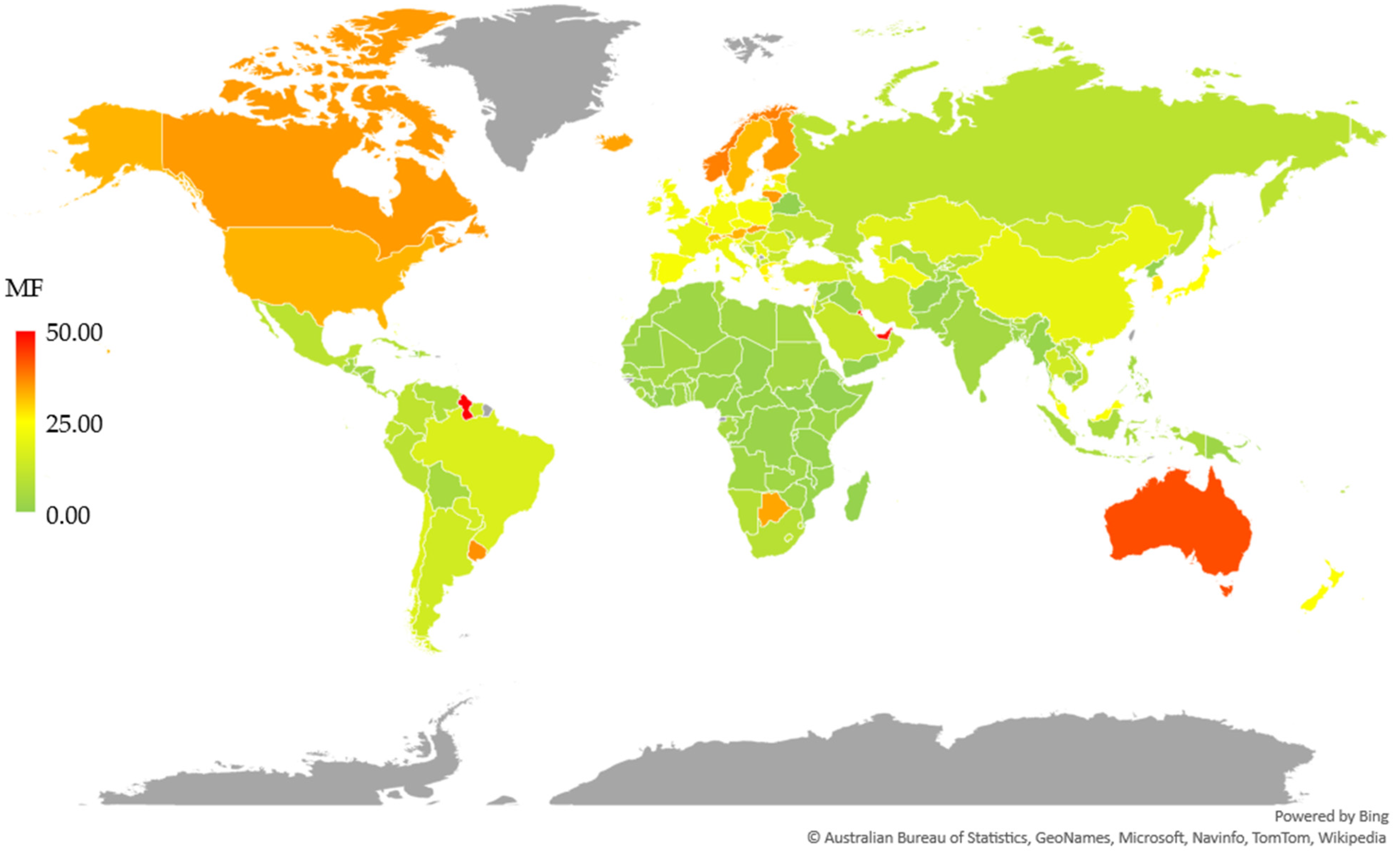

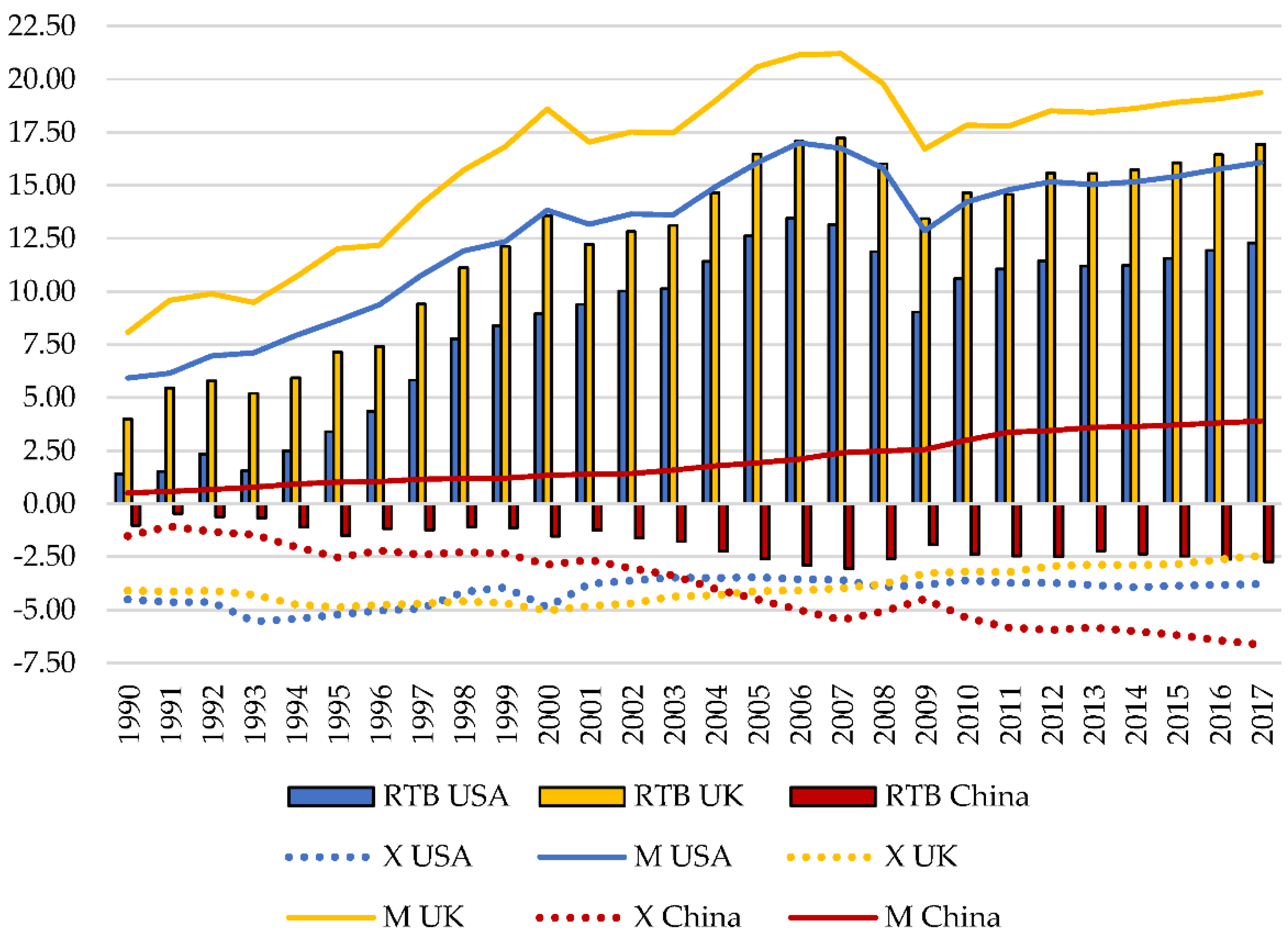
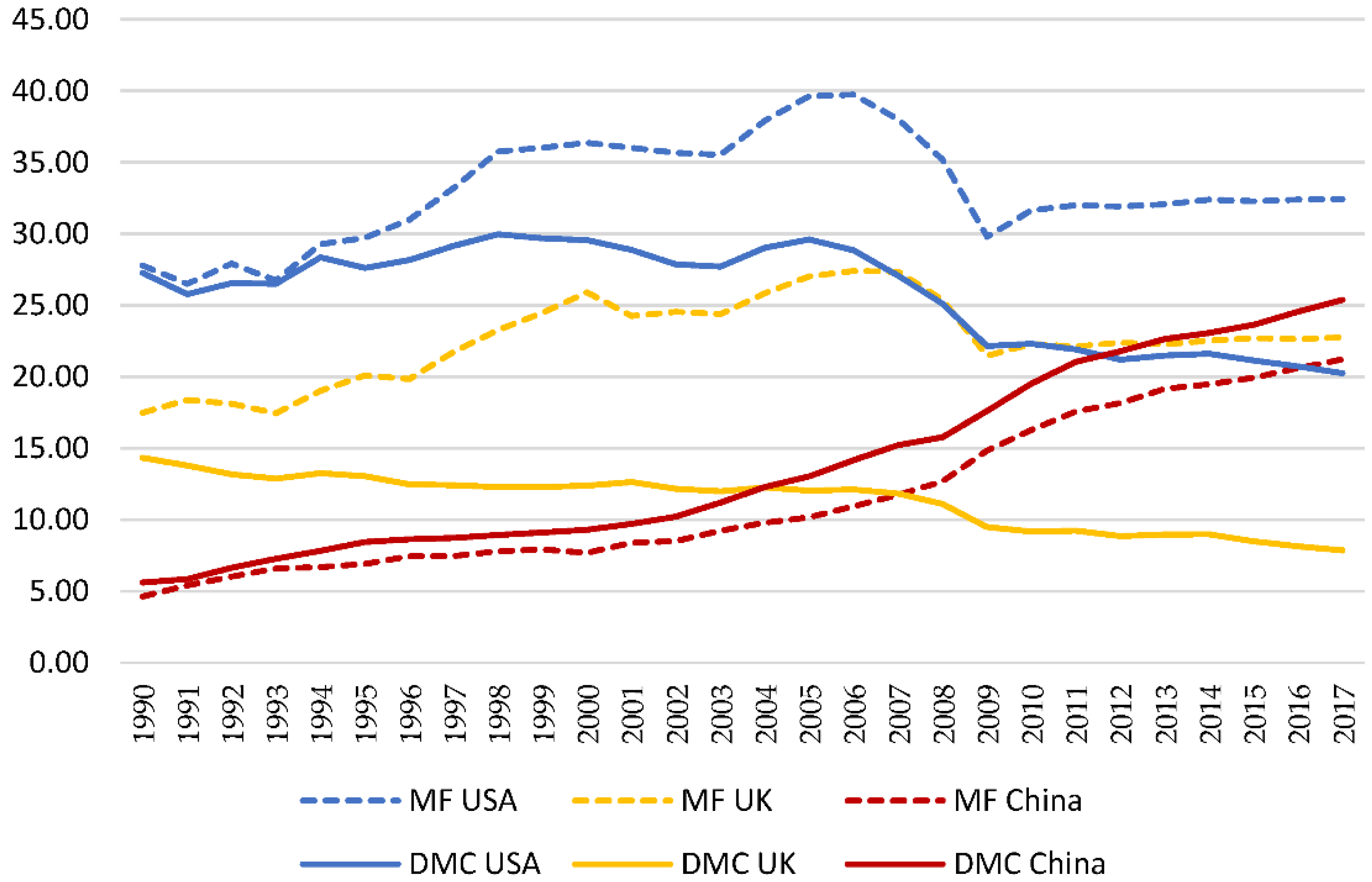
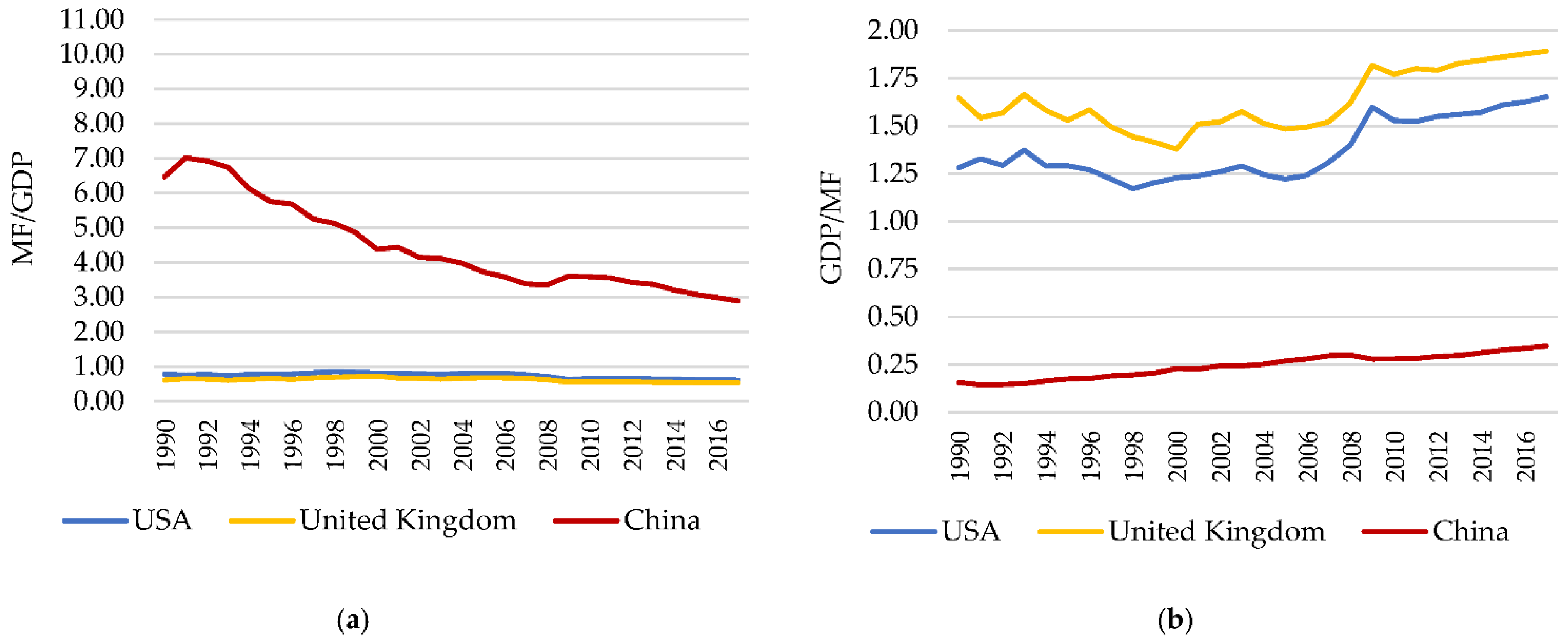
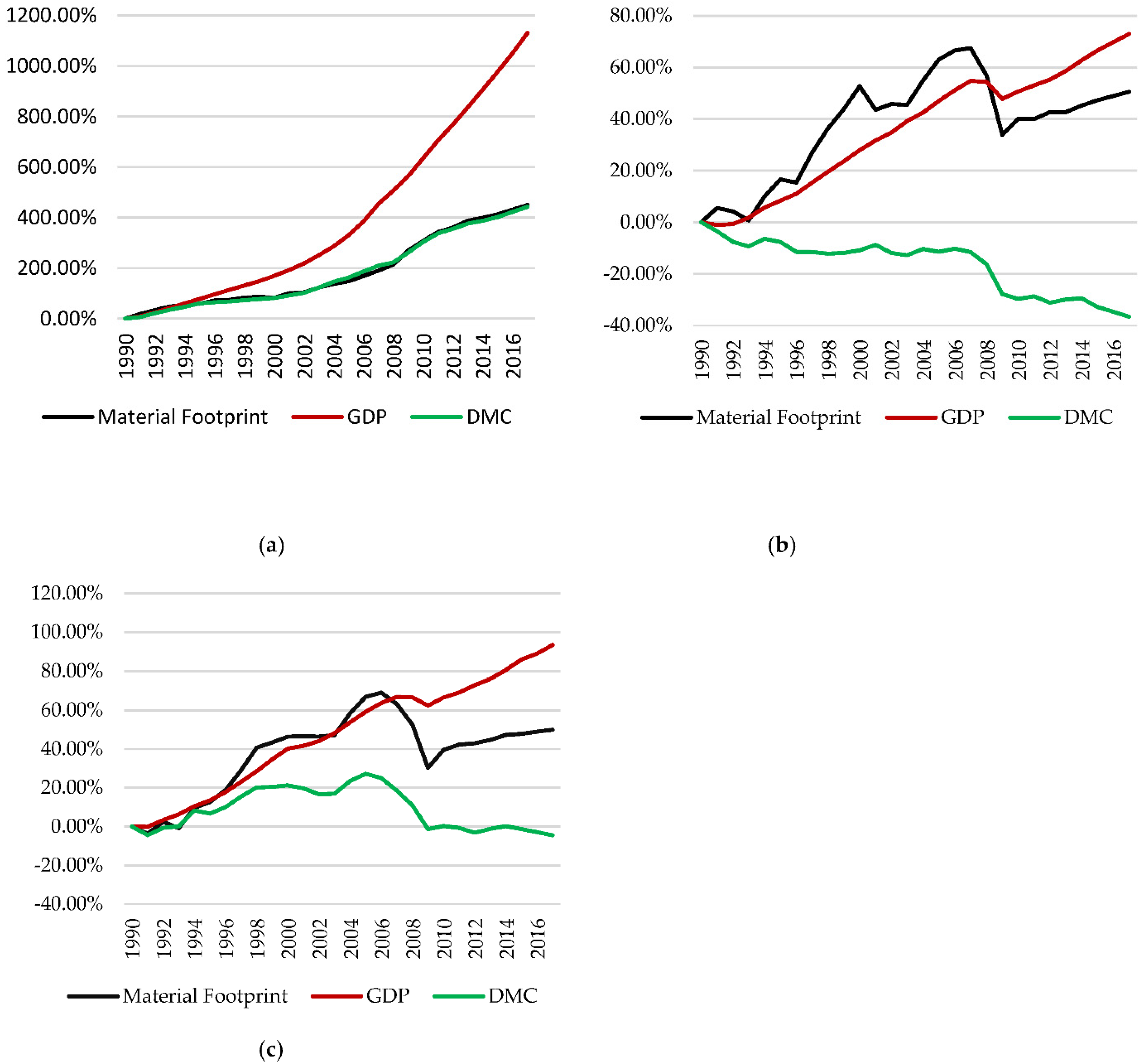
| Country | Ratio (DMC) 1990–2017 |
|---|---|
| United Kingdom | 0.37 |
| USA | 0.49 |
| China | 0.44 |
| Country | Year | GDP (USD 2010) | DE (Tonnes) | DMC (Tonnes) | Imports (Tonnes) | Exports (Tonnes) | Decoupling Ratio |
|---|---|---|---|---|---|---|---|
| United Kingdom | 1990 | 28,764.49 | 13.49 | 14.34 | 2.64 | 1.80 | 0.37 |
| 2017 | 43,010.71 | 5.82 | 7.85 | 3.63 | 1.60 | ||
| USA | 1990 | 35,599.40 | 26.38 | 27.27 | 2.32 | 1.43 | 0.49 |
| 2017 | 53,552.49 | 20.14 | 20.26 | 2.20 | 2.07 | ||
| China | 1990 | 717.02 | 5.65 | 5.62 | 0.05 | 0.08 | 0.44 |
| 2017 | 7346.84 | 23.98 | 25.39 | 1.70 | 0.29 |
| Country | Ratio (MF) 1990–2017 |
|---|---|
| United Kingdom | 0.87 |
| USA | 0.78 |
| China | 0.45 |
| Country | Year | GDP (USD 2010) | MF (Tonnes) | IFB 1 (Tonnes) | Imports (Tonnes) | Exports (Tonnes) | Decoupling Ratio |
|---|---|---|---|---|---|---|---|
| United Kingdom | 1990 | 28,764.49 | 17.48 | 2.45 | 8.08 | 4.10 | 0.87 |
| 2017 | 43,010.71 | 22.75 | 15.73 | 19.38 | 2.45 | ||
| USA | 1990 | 35,599.40 | 27.79 | 0.52 | 5.93 | 4.51 | 0.78 |
| 2017 | 53,552.49 | 32.43 | 12.17 | 16.07 | 3.78 | ||
| China | 1990 | 717.02 | 4.64 | −0.94 | 0.51 | 1.53 | 0.45 |
| 2017 | 7346.84 | 21.23 | −2.62 | 3.89 | 6.64 |
Publisher’s Note: MDPI stays neutral with regard to jurisdictional claims in published maps and institutional affiliations. |
© 2021 by the authors. Licensee MDPI, Basel, Switzerland. This article is an open access article distributed under the terms and conditions of the Creative Commons Attribution (CC BY) license (https://creativecommons.org/licenses/by/4.0/).
Share and Cite
Alonso-Fernández, P.; Regueiro-Ferreira, R.M. An Approximation to the Environmental Impact of Economic Growth Using the Material Flow Analysis: Differences between Production and Consumption Methods, Applied to China, United Kingdom and USA (1990–2017). Sustainability 2021, 13, 5489. https://doi.org/10.3390/su13105489
Alonso-Fernández P, Regueiro-Ferreira RM. An Approximation to the Environmental Impact of Economic Growth Using the Material Flow Analysis: Differences between Production and Consumption Methods, Applied to China, United Kingdom and USA (1990–2017). Sustainability. 2021; 13(10):5489. https://doi.org/10.3390/su13105489
Chicago/Turabian StyleAlonso-Fernández, Pablo, and Rosa María Regueiro-Ferreira. 2021. "An Approximation to the Environmental Impact of Economic Growth Using the Material Flow Analysis: Differences between Production and Consumption Methods, Applied to China, United Kingdom and USA (1990–2017)" Sustainability 13, no. 10: 5489. https://doi.org/10.3390/su13105489
APA StyleAlonso-Fernández, P., & Regueiro-Ferreira, R. M. (2021). An Approximation to the Environmental Impact of Economic Growth Using the Material Flow Analysis: Differences between Production and Consumption Methods, Applied to China, United Kingdom and USA (1990–2017). Sustainability, 13(10), 5489. https://doi.org/10.3390/su13105489







